These Syllogism – CA Foundation Logical Reasoning Questions are designed strictly as per the latest syllabus and exam pattern.
Syllogism – CA Foundation Logical Reasoning Questions
“Logic” word is derived from the Greek noun “logos” means “thought”.
Syllogism is a Greek word that means “Inference or deduction”. These deductions are based on propositions (Premise).
Proposition (Categorical statement) / premise is a grammatical sentence com-prising of four components,
(i) Quantifier (ii) Subject (iii) Copula (iv) Predicate
Let us consider the following sentences :
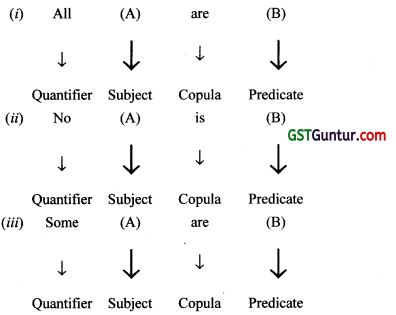
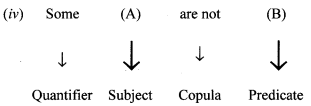
Clearly; with the help of Quantifier and Copula, a relationship between subject and predicate is established.
![]()
Components of Proposition / Premise
- QuantifierThe words “All”, “No” and “Some” are called Quantifiers because they specify a quantity.
There are two types of Quantifiers
I. Universal Quantifiers “All” and “No” are called Universal Quantifiers because they refer to each and every object of a certain set.
II. Particular Quantifier“Some” & “Some not” are called Particular Quan¬tifiers because it refers atleast one existing object in a certain set. - Subject : The part of the sentence, something is said about that is called subject. It is denoted by “S”.
- Copula : The parts of the proposition that denotes the relationship between subject and predicate is called copula.
- Predicate : The parts of the proposition which is affirmed denied about that subject is called predicate. It is denoted by P.
Classification of Proposition
1. Categorical Proposition : Here, there exists a relationship between “Subject” and “Predicate” without any condition.
Ex.
I. All boys are girls.
II. No boy is girl.
![]()
2. Hypothetical Proposition : Relationship between subject and “Predicate” is asserted conditionally
Ex.
I. If it rains, he will not come.
II. If he comes, I will accompany him.
3. Disjunctive Proposition : Here, the assertion is of alteration/optional.
Ex.
I. Either he is sincere or he is loyal.
II. Either he is educated or he is scholar.
Here, we will consider only categorical type of proposition.
Venn Diagram Representation of two propositions
Venn Diagram

Hidden Proposition Type

Let us discuss the types of hidden Propositions
1. A – Type Propositions :
I. Beginning with Quantifiers “Every” and “Any” Example
- Every cow is horse ⇒ All horses are cows
- Each of students of class XII has passed ⇒ All students of class XII have passed
- Anyone can do this job ⇒ All (men) can do this job.
![]()
II. A positive sentence with a particular person as its subject is always an A-Type proposition.
Example
(i)

(ii)

III. A sentence with a definite exception is an A-Type Proposition.
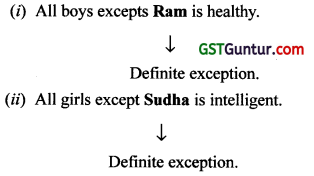
2. E – Type Propositions
I. Beginning with Quantifiers “No one” ; “Not a single”; “none” etc. are E-Type Propositions.
Example
- Not a single student could answer the question.
- None can cross the English Channel.
![]()
II. A negative sentence with a very definite exception is also a E-Type Proposition.
Example

III. When an interrogative sentence is used to make an assertion, this could be reduced to an E-Type Proposition.
Example
- Is there any person who can scale Mount-Everest ?
⇒ None can climb Mount Everest. - Is there anybody else who can solve this question?
⇒None can solve this question.
IV. A negative sentence with a particular person as its subject is E-Type proposition.
Example
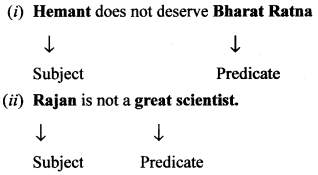
3. I – Type Proposition
I. → Propositions beginning with words “most”, “a few”; “mostly” ; “generally”; “almost”; “frequently” and “often” are to be reduced to the I-Type Propositions.
Example
- Almost all the fruits have been sold ⇒ Some fruits have been sold.
- Mostly students have qualified this test ⇒ Some of the students have qualified the test.
- Girls are frequently physically weak ⇒ Some girls are physically weak.
![]()
II. Negative propositions beginning with words as “few”; “seldom”; “hardly”; “rarely”; “little” etc. are to be reduced to the I – Type Propositions.
Example
- Seldom writers do not take rest. ⇒ Some writers take rest.
- Few teachers do not tell a lie ⇒ Some teachers tell a lie.
- Rarely scientist do not get a good job ⇒ Some scientists get a good job.
III. A positive sentence with an exception which is not definite, is reached to an I – Type proposition
Example


4. O-Type Propositions
I. Negative propositions beginning with words as “All”; “Every” ; “Any” ; “Each” etc. are to be reduced to O-Type Propositions.
Example
- All teachers are not scholar ⇒ Some teachers are not scholar.
- All that glittering is not gold ⇒ Some glittering objects are not gold.
- Everyone is not scientists Some are not scientists.
![]()
II. Negative propositions with words as “most”, “a few” ; “mostly” ; “generally” ; “almost” ; “frequently” are to be reduced to O-iype Propositions.
Example
- Boys are usually not physically weak ⇒ Some boys are not physically weak.
- Priests are not frequently thiefs ⇒ Some priests are not thiefs.
- Almost all the questions cannot be solved ⇒ Some questions cannot be solved.
III. Positive propositions beginning with words as “few” ; “seldom” ; “hardly” ; “scarcely” ; “rarely” ; “little”; etc. are to be reduced to the O-Type Propositions.
Example
- Few girls are intelligent. ⇒ Some girls are not intelligent.
- Seldom innocents are guilty. ⇒ Some innocents are not guilty.
IV. A negative sentence with an exception, which is not definite is to be reduced to O-Type Propositions.
Example
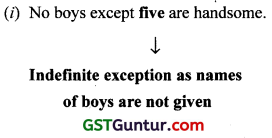

![]()
Exclusive Propositions
Such propositions start with “only”; “alone”; “none but”; “none else but” etc. and they can be reduced to either A-Type or E-Type or I-Type.
Example:-
- Only post-graduates are officers.
⇒ All officers are post-graduates → (A – Type) - None Post-graduate is officer.
⇒ No officer is Post-graduate (E – Type) - Some Post-graduates are officers (I – Type)
Types of Inferences or Deductions
1. Immediate inference :- Inference drawn from a single statement is known as immediate inference
Ex.
Statement : All A are B
Conclusion : Some B are A
Let A = {0, 1, 2} ; B = {0, 1, 2, 3, 4}
Venn diagram Representation
Clearly, some B i.e., {0, 1, 2} are A.

Inference is drawn from single statement so, It is an Immediate Inference.
![]()
2. Mediate Inference:- If conclusion is drawn from two given statements is called mediate inference.
Ex.
Statement : All A are B
: All B are C
Conclusion : All A are C
Let A = {0, 1, 2}, B = {0, 1, 2, 3} C = {0, 1, 2, 3, 4, 5}
Venn Diagram Representation

Clearly, All A are C. Inference obtained is called mediate Inference.
Method to draw Immediate Inferences
- Implication;
- Conversion ;
- Obversion ;
- Contraposition
Here, we will study only two methods : Implications and conversion.
Implication : Subject and Predicate of statement are not changed in conclusion.
Ex.
Statement : All A are B
Conclusion : Some A are B
Let A = { 0, 1, 2}
B = {0, 1, 2, 3}
Some → means → minimum one element
So, some → It may be all elements of A in B.
![]()
Conversion : In it, subject of statement becomes predicate and predicate of statement becomes subject in conclusion.
Ex.
Statement : All A are B
Conclusion : Some B are A
Let A= {0, 1,2} ; B = {0, 1, 2, 3, 4}
Venn Diagram Representation

Clearly, Some i.e., {0, 1, 2} of B are in A.
Immediately Inference Table

Venn Diagram Representation of type of propositions.
1. A Type Proposition.
Statement :- All A are B.
(i) Let A = {0, 1, 2} ; B = {0, 1, 2, 3, 4}
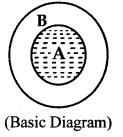
(ii) Let A = {0, 1, 2} ; B = {0, 1, 2}
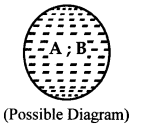
All elements of A are present in B.
Inference :
(i) Some A are B
It is true in both venn-diagrams.
(ii) Some B are A.
It is also true in both venn-diagrams.
(iii) Some B are not A.
It is true in 1st venn-diagram but not in 2nd.
![]()
Note:- If conclusion/inference is true in basic diagram as well as in all possible diagrams, then the conclusion is said True/Valid.
2. E-Type Proposition
Statement: No A is B
Let A= {0, 1, 2} ;B = {3, 4}

Inference/Conclusion Drawn
(i) No B is A.
(ii) Some A are not B
(iii) Some B are not A.
Any other reference drawn from E-Type Preposition is not valid.
3. I – Type Proposition
Statement: Some A are B
(i) Let A = {0, 1, 2, 3} ; B = {2, 3, 4}
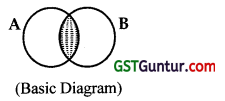
(ii) Let A = {0, 1, 2, 3, 4} ; B = {1, 2, 3}
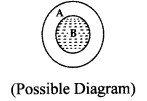
Some i.e. {1, 2, 3} of A are B.
(iii) Let A = {0, 1, 2} ; B = {0, 1, 2}
Some i.e. minimum one that may be all elements of A are in B.
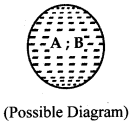
(iv) Let A = {0, 1, 2} B = {0, 1, 2, 3}
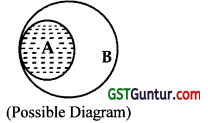
Some means minimum one element, it may be all of A are also the members of B.
Inferences/Conclusions Drawn
(i) Some B are A. (True)
It is true in Basic and all possible diagrams.
(ii) Some A are not B.
It is true in (i) & (ii) but not in (iii) and (iv)
So, this inference is not Valid.
(iii) Some B are not A.
It is true in (i) & (iv) but false in (ii) & (iii)
So, this inference is not valid.
Note:- Inference some A are not B is not a valid inference.
![]()
4. O – Type Proposition
Statement : Some A are not B
(i) Let A = {0, 1, 2, 3, 4}
B = {2, 3, 4, 5, 6}

Some elements of A i.e. {0, 1} are not in B.
(ii) Let A = {0, 1, 2, 3, 4}
B = {2, 3}

Some elements of A i.e. {0, 1, 4} are not in B.
Inference : Some B are not A is true in (i) but false in (ii), so it is not a valid inference.
Example 1.
Statements :
I. Some balls are dogs.
II. All dogs are cats.
Conclusions :
I. All cats are dogs.
II. Some balls are cats.
(a) Only I follows
(b) Only II follows
(c) Both I and II follows
(d) Neither I nor II follows
Solution:
First we should draw basic diagrams of both statements
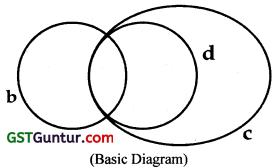
Note:- We take 1 st letter of subject or predicates as notation, i.e. Ball → b; Dog → d; Cat → c
Then, we should see given conclusions.
In basic diagram conclusion I does not follow, because “All cats are dogs is not true”. So, no need to make possible diagrams for conclusion I.
Conclusion II “Some balls are cats” is true in Basic Diagram. So, we should make all possible diagonals.
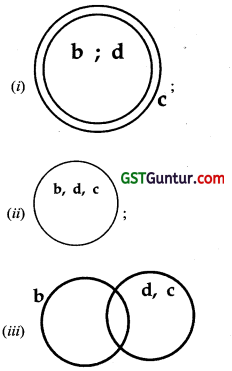
In all possible diagrams “conclusion II” is also true. So, Option “(b) only II follows” is true.
![]()
Example 2.
Statements :
I. All papers are books
II. All books are pens.
Conclusions :
I. All papers are pens
II. Some papers are not pens.
Solution:
Basic Diagonals of statements is :

Paper → Pa ; Pen → Pe ; Book → b [ because 1st the letter are same ]
In this diagonal, Conclusion I is true but Conclusion II is not true.
So, conclusion II does not follow. Here, we should make all possible diagrams for Conclusion I.

In all possible diagonals conclusion I follows. In Basic diagram, the conclusion I is true then this should be also true in all possible diagrams. If, atleast in one possible diagram, the conclusion is not true then that conclusion is not the answer. Here (a) is correct.
![]()
Example 3.
Statement :
1. All the papers are books.
2. All the bags are books.
3. Some purses are bags.
Conclusions :
I. Some papers are bags.
II. Some books are purses.
III. Some bags are purses.
Solution:
Basic Diagram
Always Prefer minimum overlapping
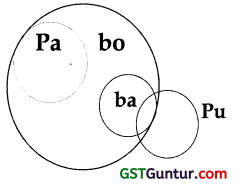
Where, Paper → Pa ; book → bo ; bag → ba ; Purse → Pu (Symbols used here).
In basic diagram, Conclusion I false but Conclusion II and III are true. So, we will make all possible diagrams for II and III.
Always remember : Possible diagrams must be true in Basic Diagram.
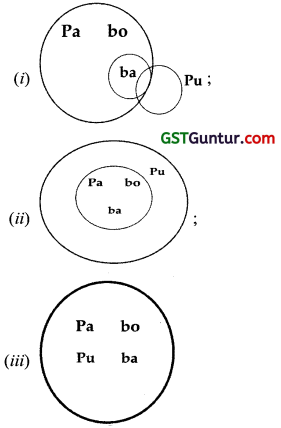
Some → Means → Minimum one.
Here, Conclusions II & III both are true in Basic and as well as in all Possible diagrams.
So, II & III are true.
![]()
Example 4.
Statement :
1. Some rats are cats
2. Some cats are dogs
3. No dog is cow.
Conclusion :
I. No cow is cat.
II. No dog is rat.
III. Some cats are rats.
Solution:
Basic Diagrams for all statements together are:

Conclusions I, II, III (all) are true in Basic Diagram.
So, we should make all possible diagrams.
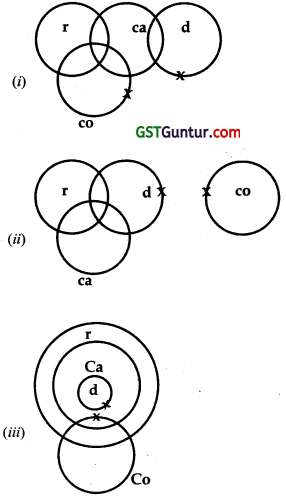
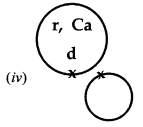
Clearly, Conclusion I is not valid in possible diagrams (i) & (iii). So Conclusion I is rejected;
Conclusion II is not valid in possible diagram (ii) & (iii). So, conclusion II is also not valid.
Conclusion III is true in Basic diagram as well as in all possible diagrams. So, Conclusion III is correct.
![]()
Either…………… or Case
Complementary pair : If one statement is true but other is false are called Complementary pairs.
Ex:- All A are B
Some A are not B
Here, no definite conclusions are drawn. Here “Either or” is possible.
Remember : Complementary pairs are
I. All + Some …. not
II. Some + no
III. Some + Some ………. not
Rules
“Either or” Conclusions are taken in the following cases
- If both the conclusions are surely wrong / false.
- If subject is same in both conclusions and predicate is also same in the both conclusions.
- Both the conclusions must follow complementary pairs i.e. one is positive but other is negative.
Example 1.
Statements :
1. All pens are pencils.
2. No pencil is book.
3. Some scales are book.
Conclusions :
I. Some pencils are scales.
II. No book is pen.
III. No pencil is scale.
Solution:
Basic Diagrams for all statements are:

Possible Diagrams are
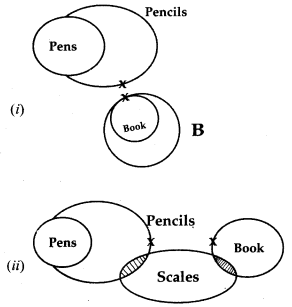
Conclusion IIAll pens are pencil but no pencil is book. Clearly means no pen is book. Conclusion II is true in Basic and all possible diagrams. So conclusion II is correct.
In Conclusions I and III subject is same and predicate is also same. Secondly one positive but 3rd is Negative Conclusion. They make complementary pairs. So, Either I or III are correct.
Hence, Conclusion II is correct and Either I or III is correct.
![]()
Example 2.
Statements :
1. All mangoes are fruits
2. No banana is mango.
Conclusions :
I. No banana is a fruit.
II. Some bananas are fruits.
(a) I follows
(b) II follows
(c) Either I or II follows
(d) Neither I nor II follows
Solutions:
In conclusion I and II both subject and predicate are same. Secondly II is positive but I is negative conclusion. So, they make Complementary pairs. hence Either I or II correct. (c) is correct.
![]()
Possibility Cases
In deciding conclusions; we follows two rules (i) if conclusion is false in basic diagram then that conclusion is said incorrect. No need to make possible diagrams.
(ii) If conclusion is true for basic diagram then possible diagrams are made. If the conclusion is also true in all possible diagrams then the conclusion is said correct. If atleast one possible diagram is incorrect, the conclusion is said incorrect.
But in possibility cases, ifthe conclusion is true in atleast one possible diagram then that conclusion is said possibility case. Let us clear it with the example given below.
Example 1.
Statements
1. Some Pare C
2. All S are P
Conclusions
I. All S are C
II. Some S are being C is possible.
Solution:
Basic Diagrams for all statements is

[Minimum overlapping in basic diagram]
Conclusion I does not follow in basic diagrams. So conclusion I is incorrect. In conclusion, if there are possibility words as can; may; cannot; may not; possible etc; then that conclusion is called possibility conclusion. Here; conclusion is true in minimum possible diagram then that conclusion is said correct. Always remember, that possible diagram should not violate basic diagram.
![]()
Here, one possible diagram can be made as
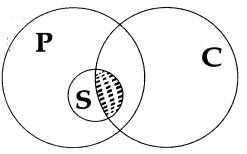
This possible diagram follows all statements and conclusion II is possible. So; conclusion II is correct.
Some Important Facts
- A few A are B ⇒ means ⇒ Some A are B
- Few A are B ⇒ means ⇒ (i) Some A are B. (ii) Some A are not B.
- Not every A is B ⇒ means =?> Same A are not B.
- Not All A are B ⇒ means ⇒ Some A are not B.
- Not a X is a Y ⇒ means ⇒ No X are Y.
- If it is an A, then it is B =» means ⇒ All A are B.
- It is a B if it is an A ⇒ means ⇒ All A are B.
- Only A are B ⇒ means ⇒ All B are A.
- None except A are B ⇒ means ⇒ All B are A.
- None but A are B ⇒ means ⇒ All B are A.
- The only A are B ⇒ means ⇒ All A are B.
- All except A are B ⇒ means ⇒ (i) No A are B and (ii) All non-A are B.
- All but A are B ⇒ means ⇒ (i) No A are B and (ii) All non-A are B.
![]()
Example 1.
Statements :
1. No Apps are program.
2. All programs are software.
3. All softwares are systems.
4. No system is hardware.
Conclusion :
I. Only systems are programs,
i.e., All programs are systems.
II. Only programs are systems.
i.e., All systems are programs.
III. No software are Apps.
IV. Some Apps are hardware.
Solution:
Basic Diagrams of statements are

Possible Diagrams are
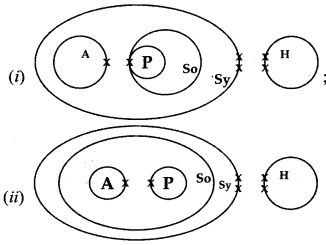
Conclusion I is correct because it is true in Basic diagram as well as in all possible diagrams.
Conclusion II is false in Basic Diagram. So, it is incorrect.
Conclusion III is false in possible Diagram (iii). So; it is also false.
Conclusion IV is false in basic diagram. So, no need to check it in possible diagrams.
So conclusion IV is not correct.
![]()
Example 2.
Statement :
1. No A is B.
2. All B are C
3. AH A are D.
Conclusion :
I. Some D if they are B must be C.
II. Some A which are C may also be B.
Solution:
Basic Diagrams of all statements is
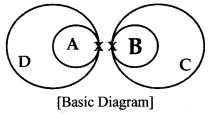
Possible Diagrams may be
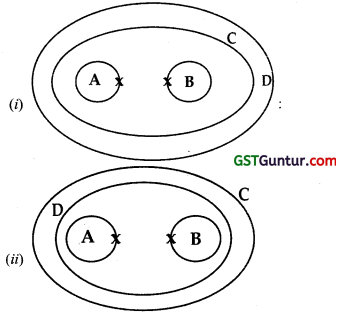
In Conclusion I; word “must” represents certainty but word “if” expresses possibility. Clearly; conclusion I does not follow basic diagram but it is true in both possible diagrams.
So, conclusion I is true.
In conclusion II; Some A which are C means “A” may also be B, never be correct because its no possible diagrams can be made. So, conclusion I is true.
![]()
Previous Year Exam Questions
Directions (1-3): Each of the following questions contains two statements followed by two conclusions number I and II. You have to decide which of the given conclusions definitely follows from the given statements.
Question 1.
Statements : [1 Mark, Nov. 2018]
1. Some phones are watches
2. All watches are guns
Conclusions :
I. All guns are watches
II. Some guns are phones.
(a) Only conclusion I follows
(b) Only conclusion II follows
(c) Neither I nor II follows
(d) Either I or II follows
Solution:
(b)
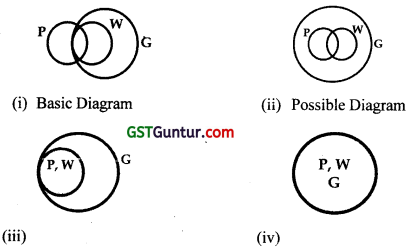
![]()
Question 2.
Statements : [1 Mark, Nov. 2018]
1. Some books are pens
2. No pen is pencil
Conclusions :
I. Some books are pencils
II. No book is pencil
(a) Only conclusion I follows
(b) Only conclusion II follows
(c) Either I or II follows
(d) Neither I nor II follows
Solution:
(c) ; I and II are complementary pairs.
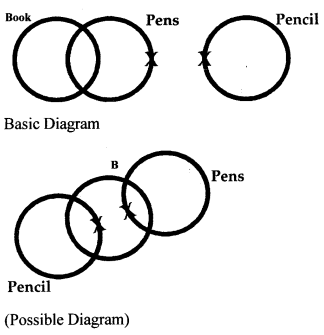
![]()
Question 3.
Statements: [1 Mark, Nov. 2018]
1. Some players are singers
2. AIl singers are tall
Conclusions:
I. Some players are tall
II. All players are tall
(a) Only conclusion I follows
(b) Only conclusion II follows
(c) Either I or II follows
(d) Neither I nor II follows
Solution:
(a)
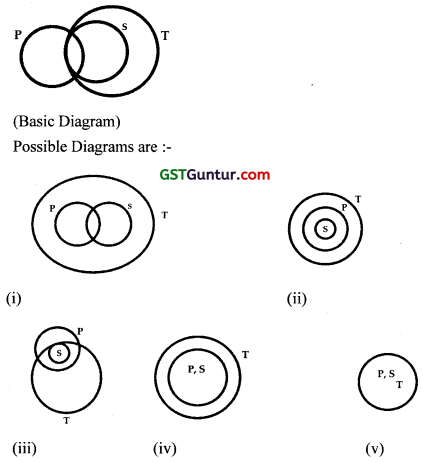
Conclusion I is true in basic as well as in all possible Diagrams.
![]()
Question 4.
Statements : [1 Mark, June 2019]
I. Sachin is a boy
II. All boys are good
Conclusions :
I. All boys are Sachin
II. Sachin is not a good boy
(a) If only I follow
(b) If only II follow
(c) If both I & II follow
(d) If neither I nor II follow
Solution:
(d)

Basic Diagram
Conclusions I & II both are false in the basic Diagram.
So neither T nor II follows.
![]()
Question 5.
Statement: I. Some fools are intelligent [1 Mark, June 2019]
Statement: II. All intelligent are great
Conclusion: I. Some fools are great
Conclusion: II. All greats are intelligent
(a) Conclusion I follows
(b) Conclusion II follows
(c) Neither I nor II follows
(d) Either I or II follows
Solution:
(a)
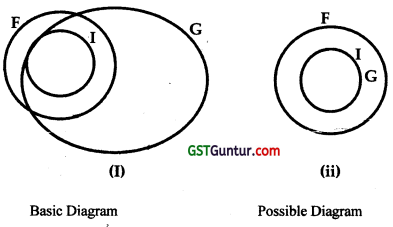
(a) Conclusion I follows.
Question 6.
Statement: I. Sohan is good Sports man. [1 Mark, June 2019]
Statement: II. Sports man is healthy.
Conclusion : I. Sohan is healthy.
Conclusion : II. All sports men are good.
(a) Conclusion I follows
(b) Conclusion II follows
(c) Neither I nor II follows
(d) Either I or II follows
Solution:
(a)

Basic Diagram
So conclusion I is followed.
![]()
Question 7.
Statement: I. All the actors are girls. [1 Mark, June 2019]
II. All the girls are beautiful.
Conclusion : I. All the actors are beautiful
II. Some girls are actors
(a) If only I follow
(b) If only II follow
(c) If both I & II follow
(d) If neither I nor II follow
Solution:
(c)
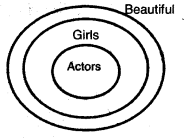
![]()
Basic Diagram
All the actors are girls ⇒ Its conversion is → “Some girls are actors” is also true.
So, option (c ) is correct.